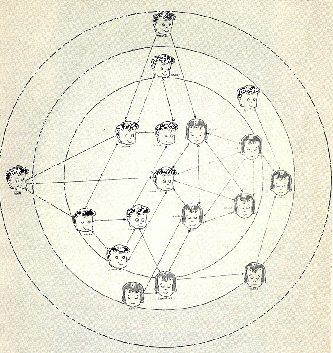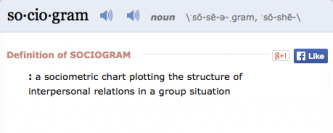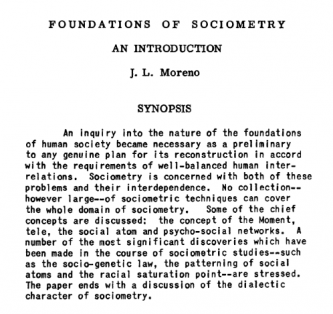User:Lidia.Pereira/GRS/SG
Abstract:
Studying the genealogy of the sociogram it is possible to begin to fathom the patterns which pervade contemporary modes of production. From the concepts of cybernetics/governance, abstraction of complex social subjects into sterile graphic representations and an ideological attempt to enforce positivist paradigms in normative structures, the history of the sociogram guides us through the concepts of social engineering, sociometry, relational databases and other tools for governance.
Sociogram
What is it?
The sociogram is a graphical representation of social relantionships in the terms of nodes and links, where every node represents a person and every link represents a relationship.
Merriam-Webster Dictionary:
History
In the late 1930's, Jacob Levy Moreno, psychologist and the founder of sociometry, accomplished quite a successful intervention at the New York State Training School for Girls Hudson, whose drop out rate was way above average. Diagnosing the problem as one embedded in the existing network of social relationships between the girls, he conducted a simple survey to help him "map the network" - thus creating a sociogram. By studying the girls answers (e.g.: "Who do you want to sit next to?") and juxtaposing them to the current dormitory arrangements, he was able to avoid conflicts by re-allocating them. This proved effective in diminishing the runaway rate. By re-engineering their social relationships, Moreno was able to create a better functioning, more productive network.
Social Engineering
"The aim of social engineering was to make society rational and train the state for maximum efficiency in the same way my father trained workers. He believed society could be controlled like a machine. The aim was to install these social engineering machines all over the USSR. These machines would make society function totally rationally. Man would become a rational component of the machine." Alexei Gastev Jr.
The oficial definition of the term social engineering describes it as "a discipline in social science that refers to efforts to influence popular attitudes and social behaviors as a large scale, whether by governments, media, or private groups."
In "Foundations of Sociometry", Jacob Levy Moreno aknowledges the importance of informational technologies over networks by observing the distorting effect of the printed page over human spontaneity. Such observation made Moreno realize the effects of the superimposition of a "mechanical-social network" upon a "psycho-social network" in removing society from human control.
Being human spontaneity the core of social sciences, it is important for the construction and planning of human society, according to Moreno, to have full knowledge of the central infrastructure of human relationships. This is the fundamental aim of any given sociometric experiment. "The social scientist must, of necessity, acquaint himself, in the research phase, with the individuals themselves and the interrelations between them. Analysis and action, social research, and social construction,are interwoven.". This research is all the more accurate if every social atom participates. Participation entails better tracing of patterns, habits and relations, in this way making social engineering all the more fine-tuned towards general productivity.
In "Open Society", Karl Popper distinguishes between Utopian Social Engineering and Piecemeal Social Engineering. Utopian Social Engineering dictates that all rational actions must be taken in light of a ultimate aim. Thus, this aim must be the first thing to be specified and only then can a plan be drawn. Politically speaking, this aim represents the Ideal State. Piecemeal Social Engineering, on the other hand, may or may not have an idea of the Ideal State, but takes such stage as distant. Therefore, it aims to search and fight the immediate problems in society, avoiding unhappiness whenever possible, doing the possible to "improve the lot of men" instead of postponing action until more favourable conditions are reached. In Popper's opinion, this approach is the most methodogically reasonable.
It is interesting to note the utilitarian connection of social engineering to the Taylorist system, also known as the scientific organization of labor, whose purpose is one of improving economic efficiency by the application of positive scientific laws to the analysis and implementation of workflows. Taylorism enjoyed widespread acceptance in the early stages of the Soviet Union, namely by Vladimir Lenin and Leon Trotsky. Alexei Gastev, the founder of the Central Institute of Labour whose work most contributed to the spreading of taylorist ideals, believed that revolution could only be recognized as such if the workers were empowered to control the work processes. He trained workers to behave and think in a rational way, going so far as to build a social engineering machine, whose ways nobody, to this day, understands.
Ayn Rand, another Russian, fled the country in the 1920's to move to California. Her philosophy was that of "objectivism", deriding human altruism and propagating, instead, the "virtues of selfishness". Like Gastev, she was obsessed with the idea of rationality. However, instead of rationality being seen as a means of state control, the only rational option, in the objectivist point of view, was to free human kind of all forms of political control and live life according only to one's own selfish desires. Despite the bad reception of her book "Atlas Shrugged" in the time it was released, for her ideals were perceived to be dangerous, forty years later it was the second most influential book in America. Especially influential amongst Silicon Valley entrepeneurs, reading groups were formed to spread her ideas. They saw themselves as Randian heros, that is, rational individuals who follow their own path despite everything else. According to "Watched Over By Machines of Loving Grace - Love and Power", this project intended also to set the computer as a way to turn everyone into their own hero, in that way encouraging the ideal that no central government was needed, because order in society would be achieved through networking. (Was this the ultimate goal of Gastev's social engineering machine?)
Soul Engineering
In "Governing the Soul: the Shaping of the Private Self", one of the general problems that Rose proposes to address concerns the social shaping of the human subject. Social thinkers such as Karl Marx and Adam Smith reflected on the relationship between social context and its inhabitant subject; sociology and psychology were not separated entitities. Where these thinkers asked how human subjectivities were socially determined by the surrounding apparatus, Rose asks: "how have persons been shaped by prevailing ways of thinking about human beings and acting upon them?". With the "birth of a new area of expertise" in the area of the psy sciences, it has become evident the tendency towards the engineering of the soul - never before was human subjectivity so carefully managed, so instrumental to the general economical efficiency of society.
If this is a rather contemporary tendency, these same ideas of studying the subjective preferences and traces of an individual appear in Moreno's experiment at the New York State Training School for Girls Hudson. It was by studying the girl's intersubjectivity that Moreno was able to devise the sociogram, the model through which he should re-engineer the school dormitory arrangements.
Evolution?
"The larger-than-life personalities of fearless dissidents that melted the icy heart of the Stasi officer in The Lives of Others are barely visible to the Internet police, who see the subjects of surveillance reduced to one-dimensional, boring database entries." Evgeny Morozov, "The Net Delusion"
It was in the year of 2007, during the Facebook F8 conference, that the term Social Graph - an hybrid between a relational database and a sociogram - was introduced. It is here interesting to understand the reason that witnessed the birth of the relational database, in 1970, in the realm of computation: intended to substitute the hierarchical database, the relational database was yet another means towards the goal of increasing productivity. Instead of presenting data in a navigation unfriendly hierarchical way, where one's means of addressing data is by position, relational databases present the data and relationships between them in a table format, where information is accessible by value.
The choice of the word "graph" in Social Graph is everything but innocent, as it entails ideological assumptions of rational mathematical analysis - thus, representing one step further towards positivist ideals of fixed, simplified, predictable and rigid social structures. Three years later, in 2010, this same Social Graph becomes the largest social network dataset in the world. In this sense, it effectively approaches Moreno's ideals of participation as being key in the process of re-engineering the social. This idea seems to be supported by the fact that the definition of Social Graph has been expanded to refer to all Internet users. Most of this participation, however, is what Mirko Tobias Schäfer would classify as implicit, reliant on design choices to allow for our leisure time to be commodified in big chunks of data extracted from our interactions and habits online.
Conclusion
Is it possible that the Social Graph, then, is serving also the process of taking the governance of our soul a step further, to use Nicolas Rose's words? In the digital space, the management of the multitude of immaterial produsers calls for more efficient methods of classifying, analysing and engineering the psy. In that sense, the database, as a record of our digital self, captures our activities, preferences and even relationships, albeit in a highly bidimensional way. By feeding the algorithms that partially control the content of what we see in large social media spaces, it becomes the central model through which our "social" is engineered.
Bibliography:
Morozov, Evgeny. “The Net Delusion: the Dark Side of Internet Freedom”, 2011
Curtis, Adam. “All Watched Over By Machines of Loving Grace: Love and Power”, 2011
Curtis, Adam. “Pandora's Box: The Engineer's Plot”, 1991
Lovink, Geert. “Networks without a Cause”, 2011
Hui, Yuk and Halpin, Harry. “Collective Individuation: The Future of the Social Web”
Moreno, Jacob L. Moreno. "Foundations of Sociometry: An Introduction in Sociometry", 1941
Rose, Nicolas. "Governing the Soul: The Shaping of the Private Self", 1989



